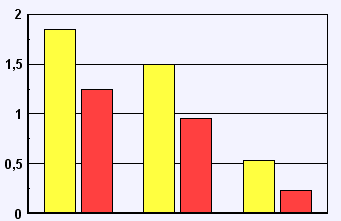|
性行為的發展
|
|
發展階段:
成人期的性行為發展 |
|
生殖行為的發展 2 |
|
在男女相互關係層面,人類的生殖行為是一個日益引起擔憂的問題。自兩個世紀前從托瑪斯·馬爾薩斯起,人口統計學家就已經對“人口過剩”感到擔憂,並且把不斷上升的出生率當作一個需要設法處理的問題。儘管馬爾薩斯的最為可怕的預言沒有成真,他所畏懼的許多人口現象仍就伴隨著我們。涉及這個議題的細節討論遠超出了本教程的範圍,不過至少其中的一個細節應該在此有所提及:
將來,有一點似乎是確定無疑的,就是最不能供養人口的那些國家會繼續有最高的出生率。換一句話說,從世界範圍看,貧窮的夫妻比富裕的夫妻會有更多的孩子。換言之:越是高收入國家,那裏的孩子就越有較多的機會開發他們的潛力,比低收入的國家有和仍將會有較低的出生率。低收入國家始終缺乏良好的教育水準和充分的就業條件,並且這些匱乏可能更為惡化。要發現這些趨勢背後的原因並不難:發達國家的婦女享受著更好的性生活品質,有便利條件使用避孕措施,並因此在尋求自我健康保健時可以避免懷孕。反過來,發展中國家的婦女常常未受教育,受限於做家庭主婦和母親的辛勞,並且難以獲得避孕藥具。
除了這些顯而易見的、由這種不同的人口增長所產生的經濟和環境問題以外,發展中國家在設法控制人口的過程中,它們究竟如何能夠做出多大的努力和應該如何做出努力,確實存在疑問。甚至將來也許更難以回答的另一個疑問是:在設法控制貧窮國家的人口中,富裕國家如何能夠做出多大的努力和應該如何做出努力?
|
|
|
 低收入 中等收入 高收入 低收入 中等收入 高收入 |
|
|
 1980 - 1998年 1980 - 1998年
 1998 - 2015年 1998 - 2015年
|
|
1980-2015年年均人口增長率
本柱形圖顯示——三類國家人口增長(%):低收入國家、中等收入國家和高收入國家。不過,因為人口基數的起點較高,在可預見的將來,預期絕對人口數量將會增加。低收入國家和中等收入國家的人口增長率高於高收入國家。資料來源:世界銀行 |
 |
|
Development of Sexual Behavior
|
|
Stages of Development: Adulthood
|
|
Reproductive Behavior 2
|
|
On the international level, human reproductive behavior is increasingly causing concern. Beginning with
Thomas Malthus about two centuries ago, demographers have been worrying about “overpopulation” and have seen rising birth rates as a problem to be managed. Although Malthus’ most dire predictions have not come true, many of his fears are still with us. A detailed discussion of the issues involved lies beyond the scope of this course, but at least one of them should be mentioned here:
It seems certain that, in the future, those countries that can least afford it, will continue to have the highest birth rates. In other words,
world-wide, poor couples will have many more children than rich couples. Putting it still another way: High income countries, where children have a better chance to develop their potential, have and will have much lower birth rates than low income countries, where a good education and good jobs are already scarce and are likely to become scarcer. The reasons behind these trends are not difficult to find: Women in developed countries enjoy greater sexual equality, have easy
access to contraception, and thus can avoid pregnancies while pursuing careers of their own. Conversely, women in developing countries are often uneducated, restricted to their roles as housewives and mothers, and have difficulty obtaining contraceptives.
Apart from the obvious economic and environmental problems resulting from this unequal population growth, there is the question of how far countries can and should go in their attempts to control their populations. Even more difficult is another question that may be asked in the future:
How far can and should rich countries go in trying to control the populations of poor countries?
Average annual population growth rates 1980-2015
|
|
|
 Low income Middle income High income Low income Middle income High income
|
|
|
 1980 - 1998 1980 - 1998
 1998 - 2015 1998 - 2015
|
|
The chart shows - in percent - the growth of populations in three groups of countries: Low income, middle income, and high income. The growth rates are declining in all three groups. However, the absolute numbers are expected to increase in the foreseeable future, because they start from a larger population base. The growth rates tend to be higher in low- and middle-income countries than in high-income countries.
Source: World Bank |